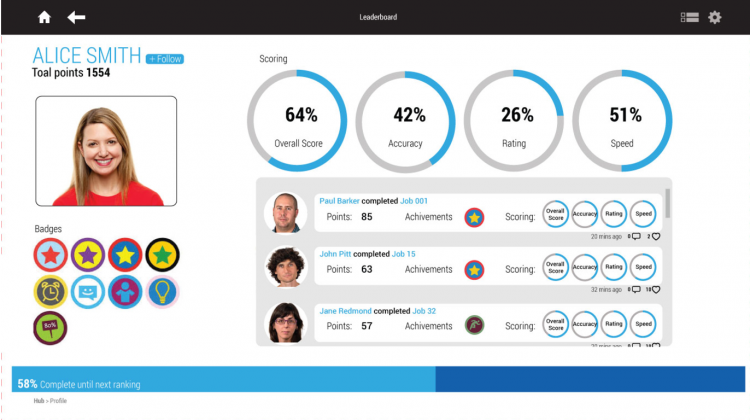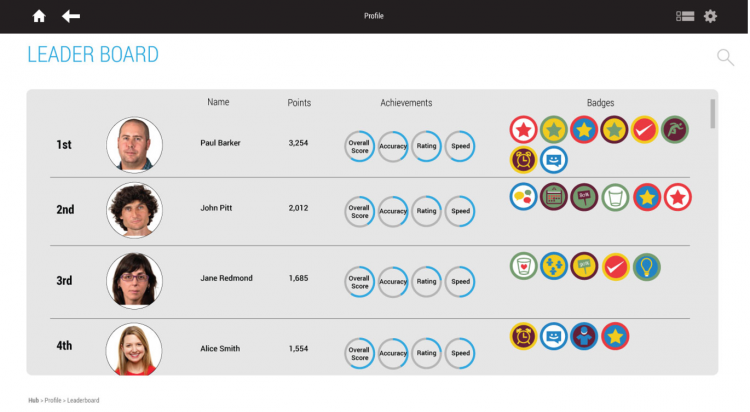CSRs are traditionally given negative feedback if call lengths or volumes increase. Metrics may include:
- Call time resolution
- Abandon rate
- Average talk time and average handle time
- Service level
- Average speed of answer
- Call quality
Under pressure to keep costs down, CSRs may not always provide the best possible experience for your subscribers. What’s more, this high-pressure working environment can lead to high employee turnover, which results in escalating hiring and training costs.
Could gamification help improve this call center conundrum?
What is Gamification?
Gamification is the use of game thinking and game mechanics in non-game contexts to engage users in problem-solving and increase contributions. In this respect, the “game” should:
- Motivate: The focus should be on intrinsic rewards (i.e. users find the job itself enjoyable), rather than extrinsic motivations (such as avoiding reprimands).
- Engage: The game design should engage users throughout the user journey funnel by taking into account where they are, what they will want to achieve next, and so on.
- Drive Behavioural Change: The game mechanics should drive behavioral changes. The game should be deeply integrated with your overall goals and strategies.
- Be Simple: A real game mechanic is short and specific: one kind of action leads to one kind of outcome.
- Personas: Gamification should be audience-specific.
- Points, Badges, Leaderboards (PBL): Users are encouraged to complete objectives, with potential rewards including recognition on leaderboards, badges, and physical prizes. While useful, PBL should not be the sole motivator for successful engagement.
- Social: The game should be inherently social and encourage interactions between users.

Figure 1: Could the social, motivational, and competitive nature of games motivate CSRs to provide faster, better service for subscribers?
Gamification within the Call Center
What if you could increase CSR motivation to reduce call times and boost first call resolution rates, while still maintaining customer satisfaction and decreasing employee stress and turnover?
Gamification in the call center could help. A responsive CSR management solution that promotes positive behavior, increased motivation, and automates processes can help improve productivity and have flow-on effects for your subscribers.
For instance, setting clear objectives and offering incentives would increase CSR engagement, while automating tasks and creating clear workflows to make those objectives attainable would also improve the subscriber’s experience — without increasing costs or call volume.
The aim should be to create, deploy, and measure challenges that keep CSRs focused on business goals and measurable outcomes. Gamification strategies to achieve this could include:
- Personalizing the process for CSRs through individual profiles
- Offering PBL incentives, making it as easy or challenging as you like to acquire badges, level up, or earn points
- Designing groups and competitions that promote positive team behavior and compel action
- Offering methods of communication between users, for example if the user needs to pass the job over to a higher level user like an administrator
- Amping up the competition with public leaderboards that rank users on metrics
- Gaining insight into what motivates CSRs with analytics and reports
- Offering feedback and ratings from Customers/Managers/Team Members

Figure 2: An example of a leaderboard used to motivate employees
For example, closing a “ticket” or support request could be a way of attaching points or badges to each job. Beyond points or scorecards, you could motivate employees with real-time feedback that can be shared and used to boost reputation. However, successful gamification goes beyond competition — it creates a sense of community and focuses on intrinsic rewards of self-improvements and achievements instead of extrinsic rewards, such as prizes. Research from CITO and Bunchball highlight that a gamification strategy should be multifaceted, as not all employees want to compete — some just want to know that they are doing their job well or receive peer recognition.
Possible Side Effects
According to Gartner, a recent survey found more than 50% of employees are unengaged with work, and a further 19% disengaged. Simply implementing gamification without considering wider business goals does not immediately equal success. The game mechanics should enhance the user experience and drive positive behavioral changes.
If not handled correctly or enforced without consent, research indicates that “mandatory fun” can actually decrease the positive effects of gamification in the workplace. This highlights the need to ensure any gamification techniques align with overall company goals and makes intrinsic rewards — enjoyment of the job — part of the strategy.
A framework for gamification for CSRs should include ways to measure success through key performance indicators (KPIs) such as:
- Reducing call times and boosting first call resolution rates
- Raise customer satisfaction rates e.g. through Net Promoter Scores
- Speed up on-boarding time
- Boost contact completion and data accuracy
- Raise productivity and efficiency
Interested in learning more about improving CSR engagement and troubleshooting? Contact our team for more information.



Submit a Comment